Custom analyses (models)
Introduction
Users can customize analysis types by rearranging topics, renaming, merging, or removing existing ones, and creating new root topics in the topic structure. These tailored topic structures allow users to align the analysis more closely with their organization’s or institution’s terminology and framework to enhance their review process and simplify result filtering, making insights more relevant and accessible.
Create a Custom analysis (model)
A Custom analysis can contain all or just a sub-set of the topics contained in one of the main analysis types - EEI, ELI or SEI.
- From the homepage, click on the
 icon located in the taskbar on the right side of your screen.
icon located in the taskbar on the right side of your screen. - Select Custom analyses from the drop-down menu.
- Click Create a custom analysis

- Enter a name for your new analysis type.
- Select to use one of the following models SEI, EEI, or ELI containing the topics you wish to use to help build your topic structure.
- Click the Use source analysis as topic structure check box to use the topic structure of the selected analysis (model) to build your custom analysis.
- Click Create.

The Use source analysis as topic structure feature provides a convenient starting point, especially when the SEI, EEI, or ELI analysis (model) largely meets your needs and only requires minor adjustments.
A new window will open, allowing you to organize the topic structure (layout). You can rename topics, combine (merge) them with others, remove them, or add new top level (root) topics.
- Click Edit topic structure
- Click +Add root topic, and use the horizontal dots next to the new field to drag and drop the topic into the desired top-level or subtopic position.
- To Rename a topic, click anywhere within the topic row and your cursor will appear in the topic name field so that you can modify the name of the topic.
- To remove a topic, click the X to the right of the topic.
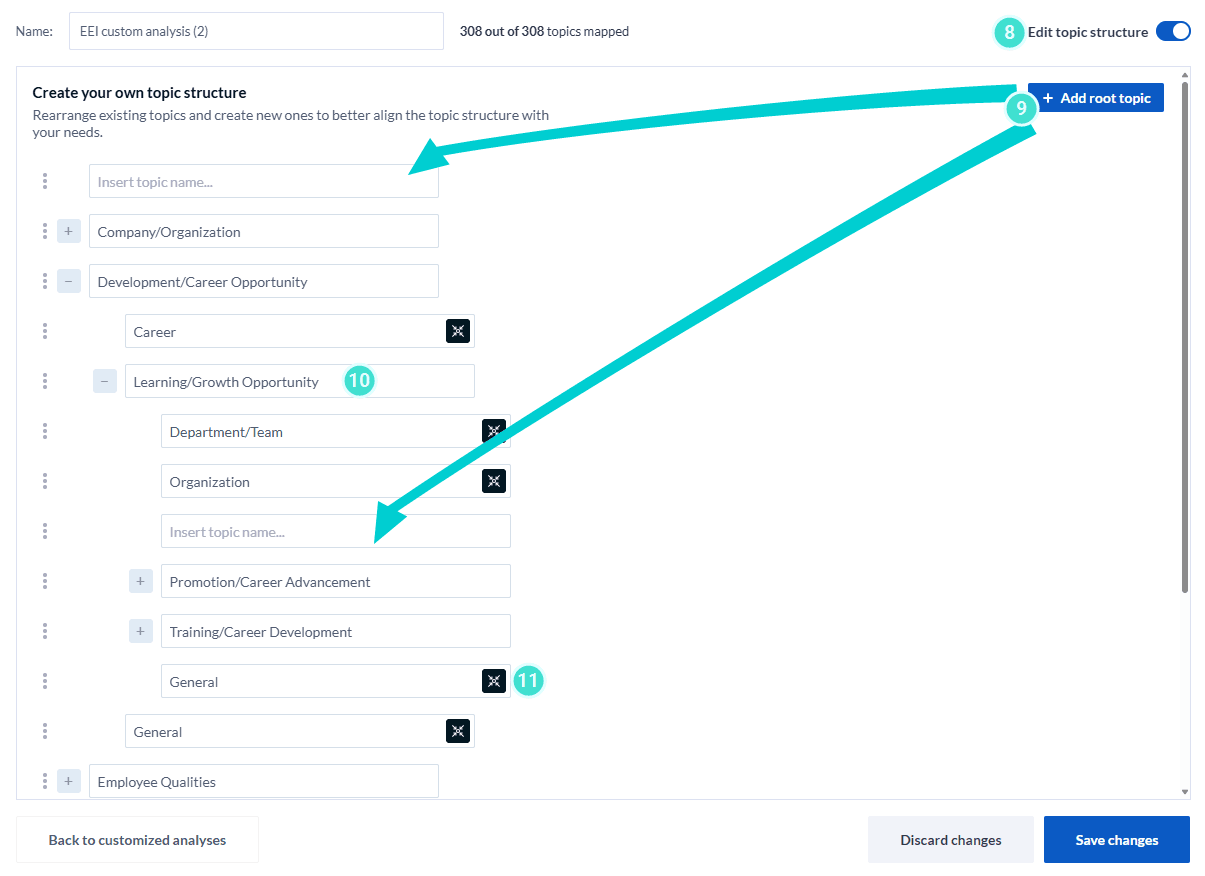
As you rearrange, rename, delete and move your topics, a counter at the top of the screen indicates the number of topics out of total topics that have been mapped to your new custom analysis. To view the topics still available from your source analysis, click on Map topics which allows you to merge or insert topics back into your model, if needed. See steps 17 to 21 for instructions.
Important: If you delete a topic and don't reuse it in your topic structure, MLY will no longer display this topic in the analysis. This may be important if you are comparing an SEI, EEI or ELI analysis with a custom model). There may be less insights produced.
- Groups of topics can be moved to other locations in the structure. For example in this screenshot, the 'Organization' topic, along with all its related subtopics, have been moved from the 'Company' category to a new top level category at the top of this custom model which is displaying Organization as separate from the Company category. Move each group of topics, such as 'Organizational Resources', 'Organizational Structure' and 'Organizational Change' individually to preserve the topic structure within the group. Similarly, a single topic from one group can be added to an existing group or it exists alone in the top level topic structure.
- Topics can also be merged with other topics. For example in this screenshot, by clicking on the X to delete the 'Alignment' topic.
- It now appears in the Map topic panel, accessible by clicking the Map topics feature to the right of the topic you wish to add it to.
- The number of mapped topics displayed at the top of the screen has been reduced by one.
- Click the empty check box beside the topic that will be merged. For example 'Alignment" will be merged with 'Agility" in this example.
- Click **Insert topics" to move it to the desired field.
- Add the topic to the name of the field.
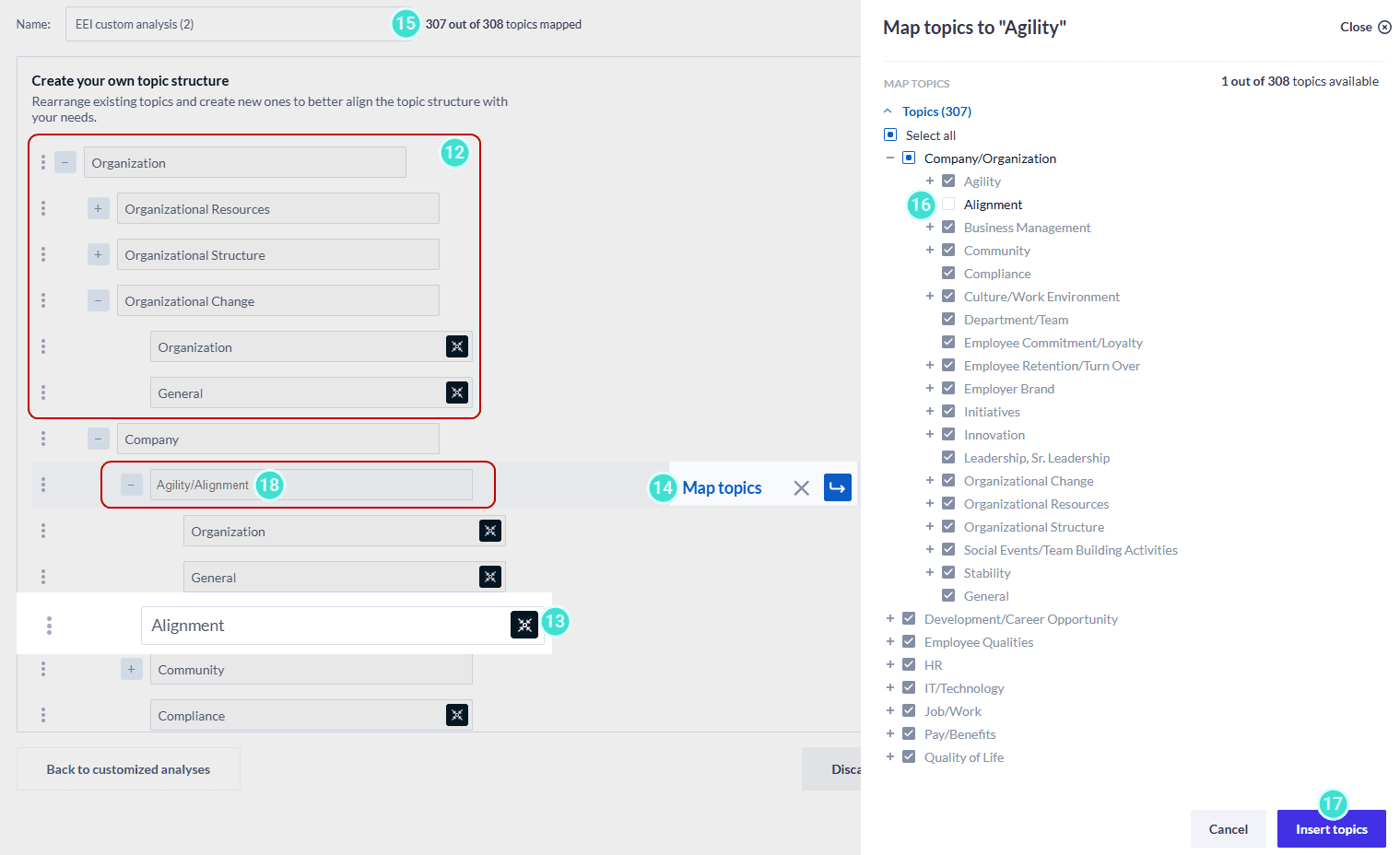
Analyze comments using a Custom analysis (model)
There are two locations within MLY where you can select one of your custom models:
- During the initial analysis of your comments in Step 2: Analysis settings, your custom models will be displayed in a the drop-down menu in the Analysis type section. You can only select one custom model at a time for the analysis. MLY will run both the custom and the original model at the same time, only adding each analyzed comment once (not twice) to your analyzed comments quota.
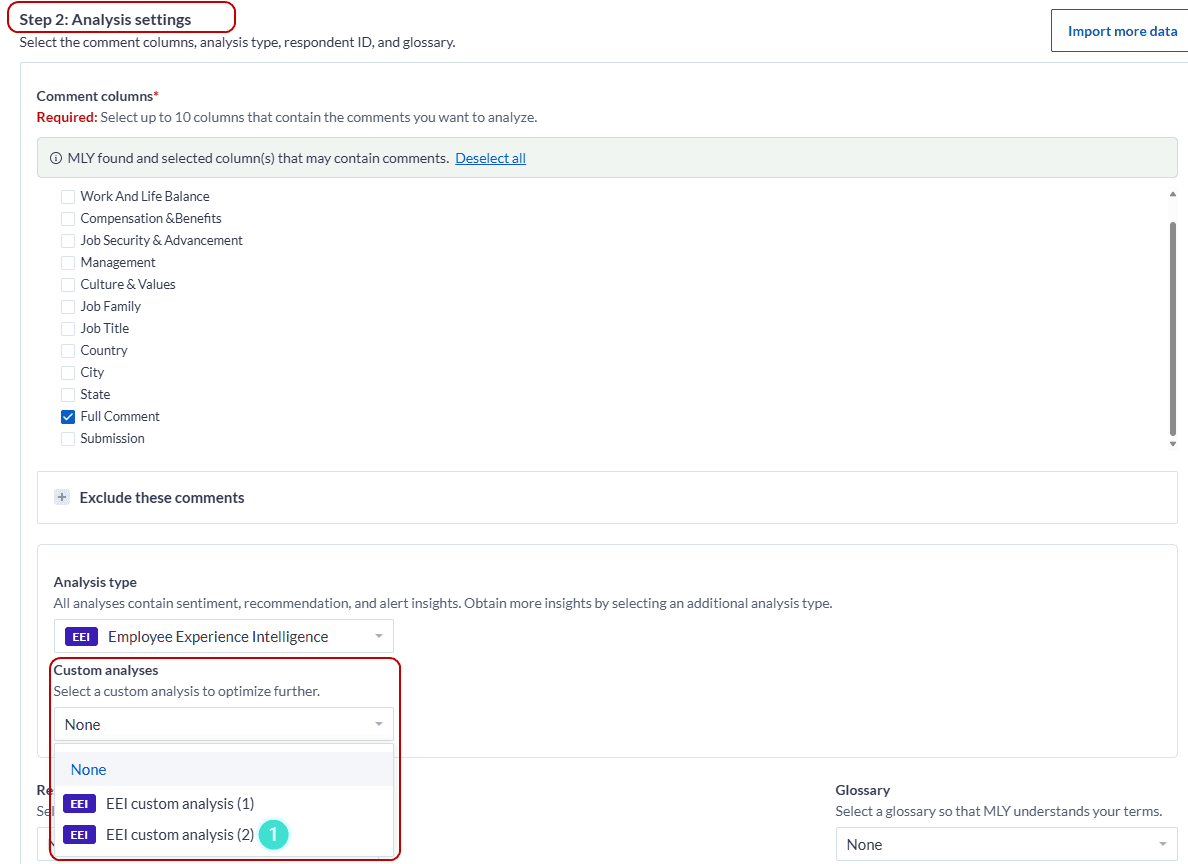
Important: If you want to analyze these comments using another version of your custom models, you have 2 choices.
- You could go back to the Step 2: Analysis settings and select another version of your custom model. When you Analyze your comments a second time, the first analysis is replaced (overwritten) with no impact to your analyzed comments quota.
- If you wish to keep your current analysis, you can reload your comments and analyze them as a new analysis which preserves your initial analysis. This is considered a new analysis, adding the analyzed comments to your quota.
- To compare the resulting analyses of the two custom models, navigate to the Comments explorer screen of each analysis and Export the comment analysis for each. Then download and compare the 2 Excel files.
- If your custom analysis has been obsoleted, because the model has been updated by Explorance, you cannot rerun that model. However, you can access your analysis to Export the comment analysis if you wish to compare the obsolete analysis with a new analysis. Navigate to Custom analyses (models) to create a new version, which will incorporate the updates made to the main model (SEI, EEI, or ELI). Then return to your analysis, and analyze with the new custom model. When the models are updated, there is no change to your analyzed comments quota for reanalyzing your comments. If you create a new analysis to run the new custom model, MLY considers this as a brand new analysis, and your analyzed comments are added to your quota.
- You can access your custom model in the Overview - Analysis properties screen and toggle back and forth between the original analysis and the custom analysis. Click on the Analysis type drop-down menu to access the other model.

Things to know about Custom analyses (models)
Updates to the Analysis type (model)
- When Explorance updates the main analysis types (models) —SEI, EEI, and ELI—both standard and custom models become obsolete. To maintain accurate analysis, customers must recreate any custom models built on these topic structures using the latest version. This ensures that the updated structure, topics, and subtopics are properly incorporated, enabling effective analysis of MLY data.
- The existing analysis created by an obsolete custom model will still be displayed in MLY and can be opened to review the results, however no updates can be made.
- To compare the results of your existing custom analysis with an updated custom model, export your current analysis data from the Comments Explorer screen using the Export comment analysis feature. For instructions, consult Export analyzed data.
- Next, create a new custom model and select it in Step 2: Analysis settings of the original analysis to reanalyze your data.
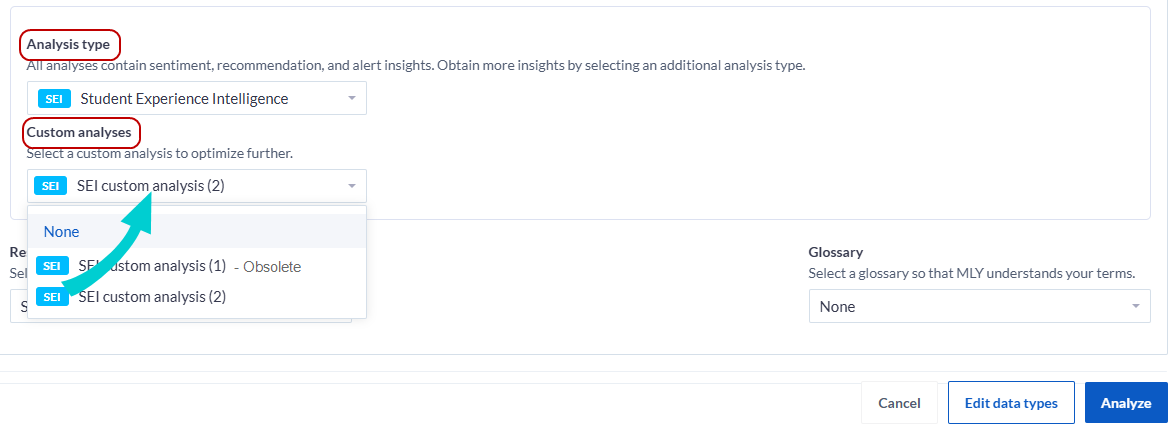
- Once the analysis is complete, open the Comments Explorer screen and export the new results. Compare the obsolete export file with the new one to review any changes.
Mapping topics
- Once you have mapped and saved topics to a top level (root) topic, you can no longer insert new topics into that section of the topic structure.
Deleting and moving topics
- The General topic contains comments that relate to the main topic but not to any of the subtopics. If the General topic is deleted from your topic structure, those comments will no longer be displayed in your analyses.
- If a top level topic has subtopics, they will be moved with the top level topic.
- Subtopics can be rearranged within the top level topic.
- Any topic that has been merged to another topic cannot be unmerged and moved.
Manage your Custom analyses (models)
- To search for an existing Custom analysis, enter its name in the search field. This search provides results based on the Customized model name column.
The following columns provide additional information about each Custom model listed which can be helpful when searching for a particular Custom model.
- All of the columns can be sorted either alphabetically or by date. Click on the columns to view the sort arrow, then click again to change the direction of the sort.
- To access a Custom model, hover on a row and click on the icon that appears. Select View topic structure from the drop-down menu on the right side of the screen.
- To delete a Custom model, click on Delete in the drop-down menu on the right side of the screen.
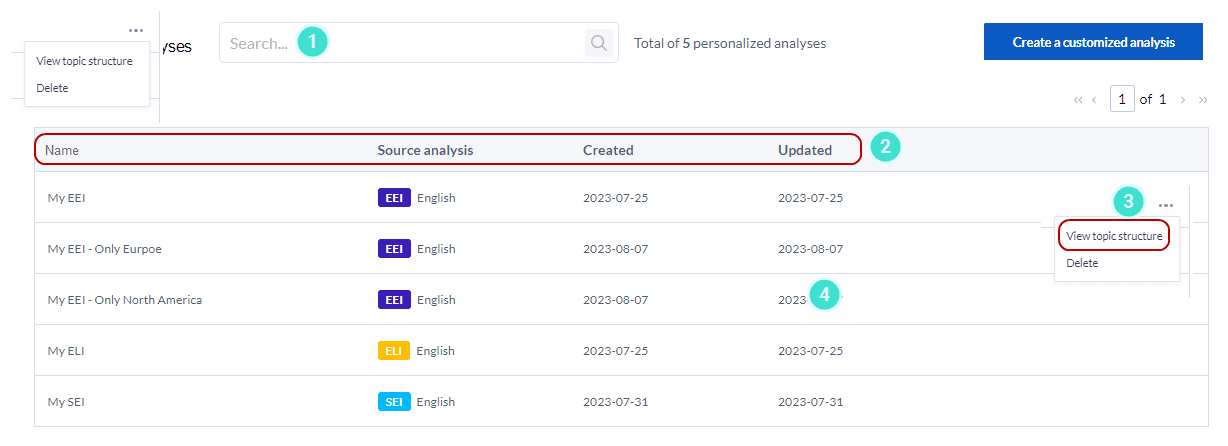
InEmployee experience intelligence (EEI)